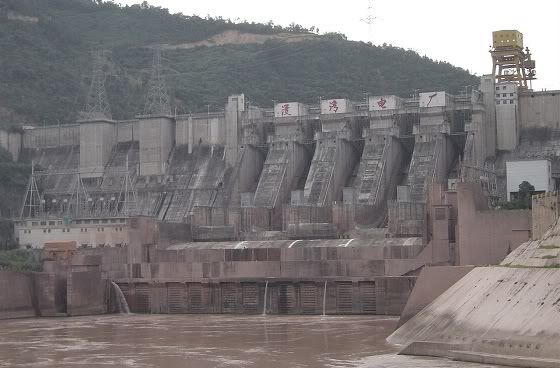Sunny Tan

Manwan Dam - the first Chinese Dam to build across the Upper Mekong River
Just a few months ago China used the Mekong River as a testing ground for its diplomacy, Chinese style. This must be seen against the backdrop of its ‘diplomacy’ of silence on the dams since Manwan, the first Chinese dam came on stream in 1992.
The high point of the diplomatic offensive, commencing in March 2010, was China ’s offer of first glimpse of its highly secretive dam, Xiaowan, to the senior government officials of riparian countries, Laos , Thailand , Cambodia and Vietnam , in early June and at a time when the most severe drought in 50 years was nearly over.
This was a mainstream dam on China ’s Mekong-Lancang River , a mammoth one, capable of generating 4,000 megawatts of electricity, its wall rose nearly 300 metres and its monstrous reservoir stretched as far as 170 kilometres upstream.
During the worst months of this year’s drought, March, April and May, the river lobbyists claimed that this dam impounded water and played an important part in the low water level of the Mekong River , but China denied it and blamed the many rainless days throughout the region.
The river lobbyists, who had access to the expertise of hydrologists, asked for water data for the period before the dam was built, the time when it was under construction and the current spell of pervasive drought. Till today there was no report that it had released such data and this gave some credibility to the accusation of the river lobbyist.
It was only in the month of March of this year that China began to shed its secretive policies on its designs on the Mekong River, triggered by the cascade of criticisms that China’s four dams had further lowered the low water level of the Mekong River and had adversely affected the 60 million people who depended on this river for their livelihood.
Thailand was the staging area for Beijing ’s offer of an olive branch because many river lobbyists were based in this country.
In March, Chen Dehai, a diplomat from the Chinese embassy in Bangkok, told journalists that the Chinese dams did not cause the record drop in the water level of the 4,660 kilometre Mekong River because the Mekong-Lancang River, the upper reach of the Mekong River in China, only contributed 13.5 percent of the Mekong’s run-off volume at the point where it flowed into the South China Sea.
In early April, Yao Wan, first secretary of the Chinese embassy in Bangkok , told the audience of river lobbyists, environmentalists and civil society people that though the Xiaowan dam commenced to impound water in July 2009, but it ceased to do so at the beginning of the dry season in 2010.
Around this time, a Chinese politician, assistant foreign minister, Hu Zhengyue went to Bangkok and spoke to Thai Prime Minister, Abhisit Vejjajiva and said China would not do anything to damage mutual interest with neighbouring countries in the Mekong .
China went on to offer more reassuring words, clearly reflected by China’s vice-foreign minister, Song Tao, who said Mekong River countries should talk together before they build any dam as they might harm the welfare of the people.
Then a top Chinese civil servant, director-general of International Cooperation, Science and Technology Department, Cheng Mingzhong, said that China would continue with its 14-dam project on Mekong-Lancang and assured the other five Mekong countries that these dams would mitigate the effects of floods and drought.
During the Mekong River Commission summit in Thailand, early April, Song Tao spoke to the foreign minister of Thailand, Kasit Piromya and the latter told the Bangkok Post, an English daily of Thailand, that China had an impressive plan for sustainable development on Mekong-Lancang and so one should not blame China for the flood and drought.
Nearly three months later, late June, two Thai politicians, though small fries compared to Piromya, voiced their opposition to China ’s plan to build 12 more dams on the Mekong-Lancang and wanted China to scrap such projects, at a riverine forum in Ho Chi Minh City , Vietnam .
By this time, one could see that there were flaws in China’s Mekong diplomacy, clearly indicated by the contradictions in the public statements of its diplomats, official and a de facto friend of China, Kasit and all these reinforced the suspicion of the five Mekong countries regarding China’s unstoppable drive to build more mainstream dams on the Mekong-Lancang River.
However, China had a hidden agenda to this diplomatic offensive. It was doing its level best to develop buddy-buddy relations with the five Mekong countries to get them to vote against the tabling of any discussion on its territorial dispute with Vietnam and Malaysia over the Spratley and Paracel islands and Scarborough shoals, located in the South China Sea, during the ASEAN Summit, Hanoi, 6-9 April.
At the end of the day, one could see that China acted like a dilettante or amateur in test-bedding its Mekong River diplomacy. In the first place the exercise was lacking in coordination so that some of the public statements on the Mekong River contradicted one another.
Secondly, China lost its sense of direction as it tried to kill two birds with one stone, as it mixed its Mekong River diplomacy with its hidden agenda to lobby the Mekong states to vote against the tabling of any discussion on its territorial dispute with Vietnam and Malaysia.
However, one should not underestimate China faltering diplomacy on the Mekong as there was the likelihood that it would bounce back to stage another diplomatic offensive, this time it would execute it in style and finesse and as good as its 60-year old African diplomacy, a runaway success.
—
Photo courtesy of International Rivers


China ‘more aggressive’ at sea
NEW DELHI – US MILITARY chief Admiral Mike Mullen said on Friday that China had adopted an increasingly aggressive stance on the high seas, with Beijing pushing territorial claims.
Adm Mullen also repeated criticism of Beijing for breaking off military contacts with the United States earlier this year, and for a lack of ‘transparency’ in its military build-up.
During a visit to New Delhi, Adm Mullen said Indian officials shared US concerns about China’s approach and agreed on the need to ensure open access to vital sea lanes across the Pacific and Indian Oceans. ‘China seems to be asserting itself more and more with respect to the kinds of territorial claims in islands like the Spratlys,’ said Adm Mullen, the US military’s top officer, referring to the island chain in the South China Sea.
‘They seem to be taking a much more aggressive approach’ in waters Beijing deems of economic and strategic interest, he told reporters. The chairman of the US Joint Chiefs of Staff said he has also moved from ‘being curious about where China is headed (militarily) to being concerned about it’.
US officials worry that China’s more assertive stance in the Pacific Ocean and its anti-ship missile arsenal, capable of striking aircraft carriers, could undercut America’s long-dominant naval power in Asia. US Secretary of State Hillary Clinton meanwhile said at security talks in Hanoi on Friday that resolving disputes over the South China Sea was ‘pivotal’ to regional stability.
Beijing’s claims over potentially resource-rich archipelagos in the South China Sea conflict with those of some members of the Association of South-east Asian Nations (Asean). Asean favours a united front on the South China Sea issue but Beijing prefers to deal with individual claimants, and was not happy that Mrs Clinton and 11 other delegates raised the matter in Friday’s talks, diplomats said. — AFP
Source: http://www.straitstimes.com/BreakingNews/Asia/Story/STIStory_557325.html
China is playing games with numbers. YEs, 13% of the Mekong water that drains into the sea comes from China. But if you look at Chang Kong, Thailand, 70% of the Mekong water is from China – with China filling Xiowan reservoir, it is very easy to see that the low water was caused by China. Their diplomacy is infantile, but their math is just silly.
China is very aggressive, selfish, haughty. She kill all the neighbouring countries since ancient time that is alway a main policy. In the modern time during the 20th century China attacked almost neighbouring countries; 1965 attacked India, 1969 Soviet Union and 1979 Vietnam. Nowaday, She proclaims 80% of South China sea belong to her.
China’s policies are use the huge of government to rival with the independent companies of developed countries. It is not an unfair rival at all by that China will reject all the competitor of any countries. If I were the western leaders I would taught China a lesson by boycott all product made in China and invest to her neighbouring countries as Vietnam, Thailand, Malaysia, Indonesia with the similar prodcut but with western standard. In a short time Chinese goods and products will no longer survived. In fact that Chinese companies alway sell in a very cheap price but the quality is very bad.
Chinese strategy is to kill people and acculturate the neighborhood by force them to depend on her. In the past, China advertised to buy cattle toenail all the border line with Vietnam and corn silk…Finally the people along the border kill all cattle and cut down the corn field to became hunger. Then she provided food and many demand. The purpose of Chinese ruler wanted the people along border rebel but we have our own trick. About two decade ago China sold eggs with very cheep price that make the navtive similar ones could not survive. The motorbike, automobile she did the same. And know the high speed railway is not exception, she stole and copied the Japanese and French hi tech then she rival unfair. The further strategy is that she will raise the price when other competitor died. Thermo-electric powers in Vietnam nowadays are the good example. Firstly, she offerred in a very low price and she won all the project in Vietnam at that field. Secondly she take all the workers, materials from home (even the toilet) to your counties. The final, she delay and no one know when they are finished. It is the main reason why Vietnam lack of electricity. That is the lesson for Vietnam and other counties all over the world.
I have never trust in Chinese product. If you sell a Chinese car in a very cheap about 1/10 of the western car I would have never bought.